3 lost Northport buildings
- Greg Nesteroff

- Sep 4, 2024
- 7 min read
Updated: Mar 30
The following Northport buildings had three things in common: all were little-celebrated; all were in rough shape when I photographed them; and all have since disappeared.
Most mining or smelting towns boom once, if at all. Northport boomed three times (at least!) followed by an equal number of not-quite-busts, due in part to a series of catastrophic fires. The first boom came with the construction and completion of the Nelson and Fort Sheppard Railway in 1892-93; the second with with construction and completion of the LeRoi smelter in 1897; and the third, which pushed the town’s population to its peak, with the sale and refurbishment of the smelter in 1915-16.
Northport’s high water mark came around 1917-18. The 1920 census pegged the population at just over 900, and by that time it was already on its way back down. (Today it’s a shade under 300.) Two of the three buildings below are from this third boom.
Gallo’s barbershop, 4th Street
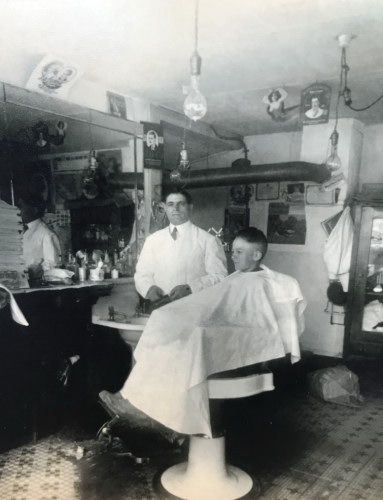
Filomeno (Filo) Gallo’s barbershop was built some time after 1929 judging from a fire insurance map seen below. Previously a two-storey bakery and restaurant stood on the site. Gallo (pictured here giving his grandson Tony Gallo Jr. a haircut, in a photo from ancestry.com) reportedly started cutting hair in Northport in 1917 but I don’t know what his original location was.
According to Patrick J. Graham’s book Colville Collection, Book Three, Gallo’s customers spanned generations. He would say “I cut your grandpa’s hair. I cut your father’s hair. Now I cut your hair!” He retired in 1954 and put the shop up for sale but I don’t know what, if anything, the building was used for after that.
Gallo died in 1969. His son Tony owned the grocery store next door, which was previously the Ore Theatre, and is now being renovated. I took three photos of the barbershop in 2011. It was torn down some time between July 2023 (when Google Street View captured it) and December 2023 (when I noticed it was gone).
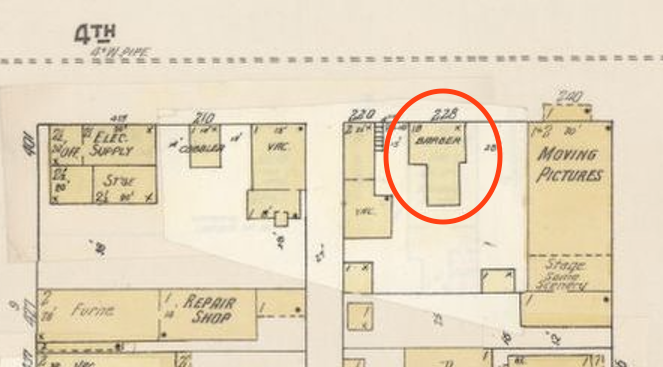


From top: 1929 fire insurance map with paste-over reflecting changes; the barbershop seen in 2011, and the site as it looks in 2024.
Medley/Riesen garage, Summit Avenue
This building wasn’t on the 1909 fire insurance map but shows up on postcards from the 1910s and appears on the 1918 fire map, seen below, labelled “lodging.”
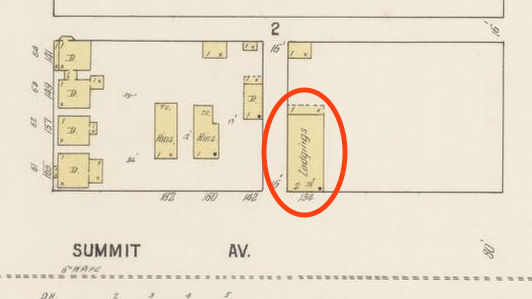
The Colville Examiner of March 11, 1916 mentioned George Chord of Genesee, Idaho expected to “expend $2,500 in the erection of a two-story business building” in Northport, “the upper story to be used for lodging accommodations, while the ground floor will be built for store rooms.” Eleven days later, the Northport News said Chord was trying to decide whether to build his hotel on Center Avenue or “on Summit avenue near the Wells hospital.”
The latter would be the right location for the building in question, but I can’t find confirmation. I checked the Northport News from March to early November 1916, but found no more mentions of Chord, nor of the site in question. So did Chord complete the building and just fall off the newspaper’s radar? Or was it built later by someone else? I don’t know.
If this was an hotel, what was it called? In addition to the New Zealand Hotel and Commercial Hotel, whose locations are known, the 1916-17 civic directory listed a Columbia Hotel, George A. Barker, proprietor, whose location is unknown. Ora E. Powell also ran an hotel whose name was not given. So maybe it was one of those.
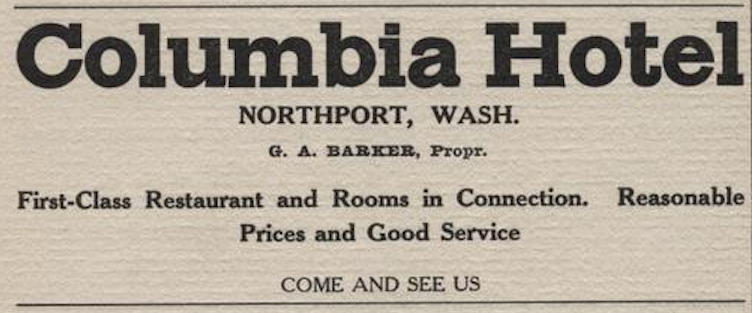
In any case, the building was shown as vacant on the 1929 fire map. But by 1944, Medley’s Garage operated there, which accounts for the addition of double doors. Mickey Riesen bought the garage the following year but I have no idea how long it operated. The building was torn down a few years ago. A pile of rubble remains.


Top postcard from 1914-16; above postcard from 1916, both by C.S. Reeves.



The building seen in 2011.

The ruins in 2024.
Liberty Hotel, Columbia Avenue
Despite being a large and prominent building on what used to be Northport’s main street, little has been written about this one. It was built in 1916 by tailor Michael Marion Michaels (1875-1958) and his wife Josephine (1885-1979). Their godson Edward Matesa wrote in Northport Pioneers: “Mr. and Mrs. Michaels were very busy people ... Also, they worked together and made the building ... Mr. Michaels was up on top the building and she carried up all the bricks to him to lay.”
While it had brick veneer, it was actually one of the town’s first concrete block buildings. It reportedly cost about $10,000 to build, with help of a $4,000 loan from the real estate firm of Buell & Allison. The building opened on Oct. 14, 1916, with a dance in its ground floor hall managed by a Mr. McGilvery, with music provided by the Schoriemmer orchestra of Rossland. About 100 couples attended. It was at that time that the building was christened the Liberty Hotel.
Within a couple of weeks, the Michaels leased the building to a Mr. and Mrs. Hicks from Chicago who planned to run it as a rooming house only. The Hickses were said to have had “many years’ experience in the hotel business,” but I’m not sure where. The hotel/rooming house had 26 rooms.
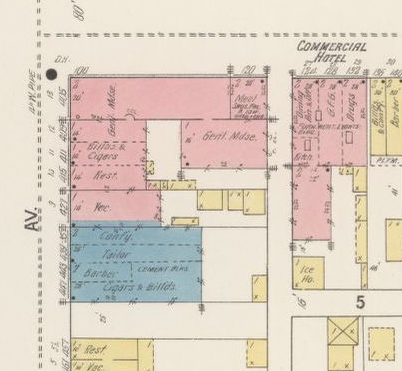
The 1918 fire insurance map (seen here where the building is marked in blue) shows the lower floor with a confectionery, a tailor shop (Michaels?), a barbershop (Filo Gallo’s?), and a pool hall/cigar stand. I don’t know where the dance hall went.
J.M. Vesnick opened a music studio in the building in 1919 and John Chervenell started a bakery in 1922. By 1929, based on another fire insurance map, it appears the entire ground floor was a restaurant.
In 1943, the Merrill Construction company rented the building while working on an ill-fated government housing project (the full story of which I may write one day). The lower floor was their office and the upper floor was workers’ quarters.
The Michaels still owned the building, although they were then living in Mullan, Idaho. In its time, it seems to have actually been better known as the Michaels building than the Liberty Hotel, even though the latter was on the sign. I’ve never seen an ad for the hotel portion and don’t know how long it operated. It wasn’t listed in the 1916-17 directory.
Trade token issued by the Liberty Hotel, date unknown.
In 1946, the Northport Masonic Lodge bought the building to convert into a new temple. According to the Colville Examiner, the ground floor “will be prepared for public gatherings and for use as a banquet room. The upper floor will be remodeled for lodge purposes, with reception and restrooms.”
A temporary lodge room was set up measuring 24x50 feet but was expected to be enlarged to 40x50. It was presumably at this time that the hotel rooms were renovated out of existence. It took until May 1949 for the building to be formally dedicated. More than 300 Masons from 40 lodges in the US, Canada, and Scotland (!) attended.
In the summer of 1950, the post office also moved into the building. It had previously been one block over in a building constructed following the great fire of 1914 that still stands. (That building belonged to realtor C.E. Allison but following his death, Filo Gallo acquired it. It is seen at far left in the picture below.)

The Michaels Block/Liberty Hotel seen at right, 1957. (Courtesy Jada Regis)
After that things get fuzzy. I don’t know how long either the Masonic Lodge or the post office were there. Amazingly, though, the post office sign seen in the photo above was just donated to the Northport Historical Society, looking very well preserved. It came from the husband of a woman who worked there while Thelma Asbell was postmaster, 1970-78.

Jada Regis of the historical society says the building was empty as of 1985. The upstairs hall still had its stage but the roof was leaking badly. It collapsed under heavy snow in the 1990s. The photos seen here are from August 2007 and I wish I took more, for by the time I returned in 2011, the building had been reduced to rubble. Near the end, you could still make out part of the sign that said “Liberty” but “Hotel” was hard to read.



Plus one that got away: Smelter ruins
Not taking any pictures of the smelter ruins is one of my biggest photographic regrets. I crawled through them on Sept. 11, 2002 and may have even had my camera with me, but I didn’t use it, mainly because I never imagined the ruins, which included one brick smokestack and a brick wall from a house, would be going anywhere.
As previously noted, the smelter opened in 1897. It operated until 1910 and again from 1916-21. In 2003 the US Environmental Protection Agency decided it wanted to clean up the site and the town. While there was some pushback from residents about what that entailed, none of it appears to have been based on losing a key part of Northport’s industrial heritage. What remained of the smelter was razed the following year. I don’t know if any photos exist of what the site looked like right at the end, but here is one Ellis Anderson took probably in the 1960s, showing two smokestacks plus the sawmill that was then on part of the site.

I was stunned to return to Northport in 2007 and discover the smelter ruins gone. The bricks were sold and used in other projects around town, although one little brick storage building somehow survived. The ruins of the brick pumping station are also visible on the riverbank. Jada Regis has done a nice post explaining this. The Northport Historical Society created a smelter monument at the north entrance to town, dedicated in 2009.
Updated on March 27, 2025 to add the Liberty Hotel trade token. Updated on March 30, 2025 to add more about the Liberty Hotel and a note that my efforts to pinpoint the origin of the Medley/Risen garage have been fruitless.














I do not think i can add anything to your request for information on Northport washington buildings but i do have vivid memories of northport starting in the mid 40's. my parents lived in patterson b.c. about 12 miles north and shopped in Northport. My dad was also a freighter and hauled materials both ways [north and south] As a child i often went with him, and also on shopping trips. To me Northport was the most exciting town i can remember, probably because it seemed that the streets were full of people and the town seemed to 'bubble', the border then was not what it is today, one could cross into the united states .before reporting to Cust…
Amazing! That puts an outside date on the building's use.
For the masonic lodge you can get more information at Browse All : Images of WASHINGTON - George Washington Masonic Memorial (lunaimaging.com)
The 1900 proceedings have the charter date of the of the lodge and a list of officers and members:
From the 1947 Proceedings the move to the building in the article
From the 1957 Proceedings
From 1980 Proceedings the news that the Northport Lodge merges into the Kettle Falls Lodge.